Since it was first introduced to the masses in the autumn of 1950, the Fender Telecaster has built a legacy that other electric guitars can only dream of. Responsible for some of the most iconic guitar tones in music history, the Telecaster’s popularity continues over 70 years after its original inception.

One constant topic of debate amongst Telecaster fanatics is which pickups get the best tone out of the Tele? Over the years, many pickups have been designed specifically to be installed on the Telecaster. Identifying the best-suited set for your taste can be a difficult process.
Over the years of tested dozens of them and in this article I’ll be showing you the best Telecaster pickups at each price point. You’ll find options for blues, rock, and many other styles.
| Name of Product | Image of Product | Description | Price Range | Full Review |
|---|---|---|---|---|
| 1. Fender Pure Vintage 64 (Best Value) |  | Type: Single Coil Position: Bridge & Neck | $110 | Read Full Review Below |
| 2. Fender Custom Shop 1951 (Best Overall) | 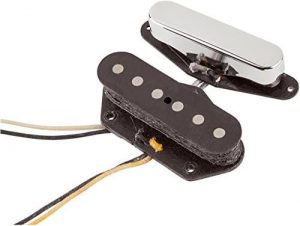 | Type: Single Coil Position: Bridge & Neck | $190 | Read Full Review Below |
| 3. Seymour Duncan Vintage Broadcaster (Editor’s Choice) | 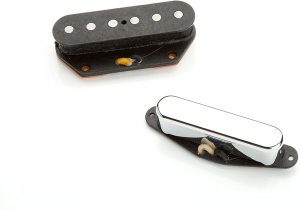 | Type: Single Coil Position: Bridge & Neck | $120 | Read Full Review Below |
| 4. Seymour Duncan Quarter Pound Tele (Best for Rock) |  | Type: Single Coil Position: Bridge & Neck | $130 | Read Full Review Below |
| 5. Fender Tex Mex (Budget Pick) |  | Type: Single Coil Position: Bridge, Middle & Neck | $100 | Read Full Review Below |
| 6. Fender Generation 4 Noiseless (Best Noiseless Telecaster Pickups) |  | Type: Single Coil Position: Bridge & Neck | $160 | Read Full Review Below |
| 7. Tonerider TRT2 |  | Type: Single Coil Position: Bridge & Neck | $100 | Read Full Review Below |
| 8. Fender Custom Shop Twisted Tele |  | Type: Single Coil Position: Bridge & Neck | $190 | Read Full Review Below |
| 9. Seymour Duncan Hot Rails | 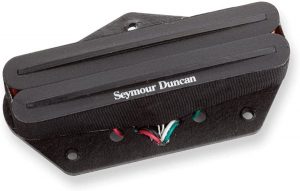 | Type: Humbucker Position: Bridge | $90 | Read Full Review Below |
| 10. Fender Deluxe Drive |  | Type: Single Coil Position: Bridge & Neck | $80 | Read Full Review Below |
| 11. Seymour Duncan Little ‘59 |  | Type: Humbucker Position: Bridge | $90 | Read Full Review Below |
| 12. Fender Custom Shop Texas Special | 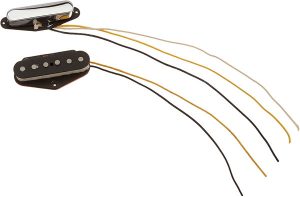 | Type: Single Coil Position: Bridge & Neck | $190 | Read Full Review Below |
| 13. Fender Pure Vintage Reissue |  | Type: Single Coil Position: Bridge & Neck | $110 | Read Full Review Below |
| 14. EMG T-System (Best Value) C | 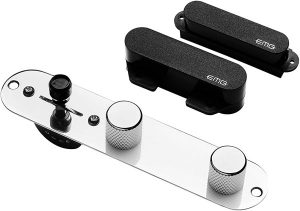 | Type: Single Coil Position: Bridge & Neck | $190 | Read Full Review Below |
| 15. Fender Vintage Noiseless (Best Noiseless Telecaster Pickups) |  | Type: Humbuckers Position: Bridge & Neck | $160 | Read Full Review Below |
Here Are the Best Telecaster Pickups
1. Fender Pure Vintage 64 (Best Value)

| Estimated Price | $110 |
| Type | Single Coil |
| Position | Bridge & Neck |
My Review: If anyone knows how to design the ideal Telecaster pickup, it’s Fender. Taking us back to the formative era of rock n’ roll, the Pure Vintage ’64 pickup set is brimming with character and power. To achieve the authentic mid-60’s look and sound, Fender has used various vintage components.
Firstly, the vintage bobbin construction gives these pickups a retro feel. Coupled with genuine original-era cloth wiring, the Pure Vintage ’64 pickups look and sound like the original models. They are wound to the precise specs that made the Telecaster such a popular instrument half a century ago.
With Alnico V magnets, you get added focus and an enhanced dynamic range. This is great for all styles of guitar playing, as it gives you complete dominion over the feel and tone of the Telecaster. The bridge pickup utilizes staggered polepieces, which provide more dynamic balance and output consistency across all six strings. Also, Fender has installed a copper shielding plate on the bridge pickup. Although this isn’t particularly impactful on the tone, it allows the magnets to flourish within the system. For that authentic vintage look and feel, the pickups are wax-potted, with an aged finish that wouldn’t look out of place on a genuine 1964 Telecaster.
What Sets these Pickups Apart: The Pure Vintage ’64 pickups manage to capture the genuine authenticity of early Telecaster single-coils. When I initially experimented with these, I must admit I was a little skeptical about how close they’d get to the classic mid 60’s Tele tone.
Right off the bat, I could tell that these pickups were the result of a meticulous design process by Fender. Many manufacturers claim to have achieved a “vintage” sound, but these pickups deliver on their promise. I was particularly impressed with the extended dynamic range they offer. Across the frequency range of the Tele, the pickups were exceptionally accurate and responsive to the velocity of my playing.
Although these pickups look exactly like the real ones used in 1964 Telecasters, I was glad to learn that Fender used some modern design tweaks to minimize the noise issues that were rife back in those days. Overall, I found the Pure Vintage ’64 pickups to deliver everything they’d promised and more!
Who is this best suited for: The Fender Pure Vintage ’64 Telecaster pickups are the perfect choice for guitarists who are particularly fond of early rock n’ roll tones. The Telecaster sounded incredible during this era, and these pickups allow you to travel back in time and get the genuine ’64 tone out of your guitar.
Bottom Line: Built with the exceptional quality you’d expect from Fender, the Pure Vintage ’64 pickups are both sonically and aesthetically pleasing. The set includes two single-coil pickups, both of which are wax-potted and fitted with trusty Alnico 5 magnets. The tone they produce is focused and sharp, enhancing Tele’s midrange and extracting every last piece of character from the strings.
2. Fender Custom Shop 1951 (Best Overall)

| Estimated Price | $190 |
| Type | Single Coil |
| Position | Bridge & Neck |
My Review: Fender’s Custom Shop ’51 Nocaster pickups offer the timeless Tele twang, with several performance-boosting features. Staying true to their heritage, these pickups closely resemble the original pickups used by Leo Fender on the earliest Telecaster models.
In the 1950s, single-coil pickups sounded notably different from the devices we commonly use today. The output was higher, and they generally sounded warmer in the midrange. To keep these pickups consistent with those vintage devices, Fender has chosen various construction techniques and materials.
Firstly, the base plate is made from tin-played copper. This material subdues the tone slightly, making it sound warmer and more in line with the vintage ’51 models. The output wire is coated in period-correct cloth, and a fiber bobbin increases the vintage feel even further.
To ensure that each string responds evenly to the velocity of your playing, Fender has used flush-mount magnets. These devices prevent the strings from resonating inconsistently when a chord is struck or a melody is played.
What Sets these Pickups Apart: Compared to all of the other Telecaster pickups on the market, the Custom Shop 1951’s sound undeniably unique. I was intrigued by the inclusion of flush-mount magnets, a feature I’d had limited experience with before trying out these pickups.
The main quality that stood out when experimenting with the Custom Shop 1951 pickups was the even response of each string. As a result of the magnets and the tin-played copper base plate, this attribute made me feel completely in control of the dynamics of the Telecaster. When I decided to dig in a little, the heat was increased appropriately, creating a highly accurate 50’s style sound.
Who is this best suited for: The Fender Custom Shop ’51 Nocaster Tele pickups are suitable for most varieties of rock music, but they’re especially well suited to conjuring up the classic vintage tones of the earliest Telecasters. If you’re looking for a way to stand out in the sea of modern guitar tones, these pickups may be the perfect way to achieve this.
Bottom Line: Using Alnico III magnets to establish a vintage tone, and with several tone-enhancing inclusions, the Custom Shop ’51 pickups are unique, to say the least. Enamel-coated magnet wire paired with flush-mount magnets ensures that these pickups stay true to the original sound they are attempting to recreate.
3. Seymour Duncan Vintage Broadcaster (Editor’s Choice)

| Estimated Price | $120 |
| Type | Single Coil |
| Position | Bridge & Neck |
My Review: The Vintage Broadcaster Tele Pickups by Seymour Duncan are a tribute to the original 1950s Fender-designed device. They come remarkably close to reproducing the highly sought-after early Telecaster tone.
To achieve this authentic vintage tone, Seymour Duncan uses several tricks of the trade. Firstly, the Alnico V magnets are slightly larger than average, with a diameter of .197 inches and a specially designed winding which represents the era of the ’50s during which Fender were the pioneers of the guitar and pickup industries.
The key to the authentic tone of the Vintage Broadcaster pickups is Seymour Duncan’s impeccable attention to detail. With hand-ground magnets, and bobbins that are hand-assembled from the traditional Forbon then dipped in lacquer before being wound, these pickups are meticulously designed.
After the pickups are wound, Seymour Duncan wraps them in a black cotton yarn. A waxed cloth hookup wire completes the vintage look, before being soldered to the coil eyelets. This results in an unmistakable vintage Telecaster look, to match the warm, inviting tone they produce.
What Sets these Pickups Apart: I’m a huge fan of Seymour Duncan’s vintage-style pickups, so I was extremely excited to test the tone of the Vintage Broadcaster set on a Tele. I was instantly drawn in by the unique look of the pickups, with the black cotton yarn wrapping capturing my attention.
The increased size of the Alnico V magnets was a feature I was skeptical about, but to my surprise, this did inject a dose of vintage goodness into the pickup’s output. And with their hand-built bobbins, it didn’t take very much time playing with these Seymour Duncan pickups to know that they’re the real deal for producing the glorious early country-style Tele twang.
Who is this best suited for: Tone-purists searching for the early Telecaster “twang” which made the guitar famous will love the Seymour Duncan Vintage Broadcaster pickups. Many manufacturers claim to have achieved this highly sought-after sound, but Seymour Duncan goes above and beyond to create an honest replication of it.
Bottom Line: There’s something special about the tone of the 50’s Telecaster. It’s the perfect sound for rock n’ roll, blues, and country guitar players. With high-quality components like hand-prepared Alnico V magnets, and a rigorous winding process that covers every small detail, Seymour Duncan delivers once again. These are easily some of the best Telecaster pickups I’ve used, especially for the price.
4. Seymour Duncan Quarter Pound Tele (Best Telecaster Pickup for Rock)

| Estimated Price | $130 |
| Type | Single Coil |
| Position | Bridge & Neck |
My Review: Since the 1970s, Seymour Duncan has been at the forefront of guitar pickup manufacturing. Their extensive range is filled with exceptional single-coil and humbucker offerings, and the Quarter Pound set is specifically designed to be installed on a Telecaster.
With the ability to power up your Telecaster’s upper midrange and highlight the “sweet spot” of the guitar, the Quarter Pound includes two distinctive pickups. One is the highest output pickup that Seymour Duncan produces, with alnico V rod magnets delivering a huge sound and a growl which resembles that of a P-90 pickup.
The ¼ inch pickups are hand polished, giving them a classy appearance. Sonically, they inject the Telecaster with fat lead tones and smooth sounding chords with a sparkly midrange and plenty of harmonic sweetness.
Seymour Duncan has designed the pickups with versatility firmly in mind. They are wax potted to eliminate any squeaks and use a traditional chrome-plated Telecaster cover to ensure that they blend seamlessly with the instrument.
What Sets these Pickups Apart: In the past, I’ve been slightly disappointed by some Seymour Duncan pickups that claim to be ideal for rock and heavier styles of playing. However, the Quarter Pound range has a lot of hype surrounding it, so I expected big things from these Telecaster single-coils.
It took a little while to find the right tone settings on the Tele to suit the fat sound of the Quarter Pound pickups, but eventually, I found the sweet spot. The standout quality that became apparent was the clean manner in which these pickups cut through the mix when jamming to a backing track.
I was also left awestruck by the growling tone you can get when cranking up the gain on your amplifier and playing powerful riffs or chords sequences in the bass and mid-tone frequencies. Despite my reservations, I soon realized that these pickups do transform the Telecaster into a perfect rock guitar.
Who is this best suited for: If you’re a multi-faceted guitarist who needs to strike a balance between single-note clarity and full-bodied chords, you’ll enjoy the Quarter Pound Tele pickups by Seymour Duncan. They’re a great choice for musicians who require additional midrange bite and rich harmonics across the frequency range.
Bottom Line: With Alnico V magnets providing tone, clarity, and power, the Quarter Pound Tele pickups are the perfect set to pair with this classic guitar. They produce sparkling midrange frequencies that are ideal for rhythm guitar, but when you need to cut through the mix, the overwound coil provides that required extra power.
Popular Related Article: 25 Awesome Strat Pickups
5. Fender Tex Mex (Budget Pick)

| Estimated Price | $100 |
| Type | Change to whatever |
| Position | Bridge, Middle & Neck |
My Review: Fender produces Tex Mex pickups for both their Telecaster and Stratocaster guitars, and the pickups have amassed a loyal following in recent years. These Tele pickups are overwound, and thus deliver a tight, clear bass, singing highs, and an energetic, high output.
With Alnico V magnets providing the smooth, solid output, and a DC resistance in the bridge of 8.0k, the Tex Mex pickups are equipped with plenty of power. You can dial in the grit and enjoy the crisp clean tones of the telecaster, or dig in and create the classic Texas grit.
The Fender Telecaster is one of those rare guitars that transcends genres and periods. That’s why the Tex Mex pickups are a great choice, they too sound timeless and are capable of producing tones that suit multiple playing styles.
Flush-mount pole pieces have been utilized by Fender, to increase the versatility of the Tex Mex Tele pickups. And as you’d expect from a set of Fender pickups, they look the part too. The neck and bridge pickups respectively are covered in classy chrome and black coverings.
What Sets these Pickups Apart: When I think of a Texas-inspired Telecaster tone, the first things that spring to mind are attitude, warmth, and power. All three of these qualities were evident from the first riff I played with the Tex Mex pickups.
I found the inclusion of flush-mount pole pieces to be interesting, as I wouldn’t usually associate them with the hot Tex Mex output. Nevertheless, Fender made the right decision. These pole pieces increased the adaptability of the pickups, consequently broadening their variety of immersive tones.
Who is this best suited for: I’d recommend the Fender Tex Mex Tele pickups to those who enjoy heated lead tones and extracting little grittiness from their guitar. These pickups are by no means designed for gain-heavy shredding, but they sound hotter than your average Telecaster single-coils.
Bottom Line: The Fender Tex Mex pickups delve into the rich history of the Fender Telecaster, enhancing and emphasizing the natural twang of the guitar. The choice of Alnico V magnets adds a little more substance to the output, and the overwound design ensures consistency across the frequency range.
Popular Related Article: 21 Of Our Favorite Humbucker Pickups
6. Fender Generation 4 Noiseless (Best Noiseless Telecaster Pickups)
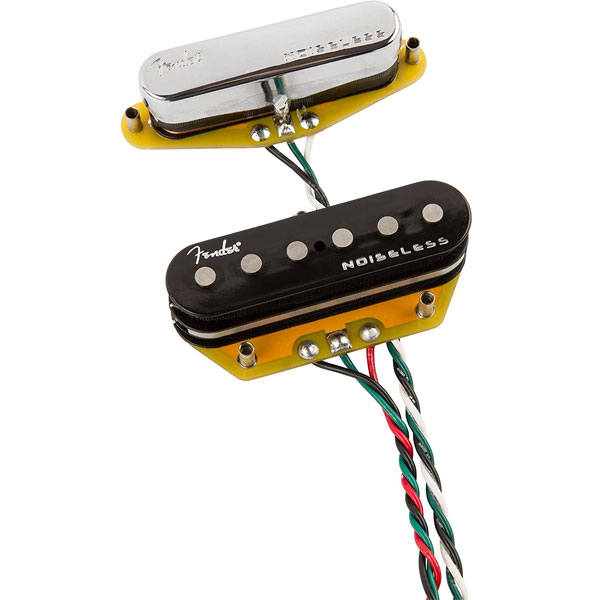
| Estimated Price | $160 |
| Type | Single Coil |
| Position | Bridge & Neck |
My Review: When Fender came up with the idea for the Generation 4 Noiseless pickups, they set out to achieve the sonic equivalent of cold fusion. This entailed combining the classic vintage-style Telecaster tone with noise-free performance.
Using the cutting-edge in pickup technology, they created these wonderful single coils. It’s remarkable how they can produce such warm and immersive tones without suffering any noise issues whatsoever. And what’s more, they are also capable of adding a layer of crunch to your Tele’s output.
Overall, the tone produced by the Generation 4 Noiseless pickups is tight and reactive. The low end is controlled, while the high end is clearly defined and smooth-sounding. The mid-tones are punchy enough to cut through the mix on stage.
To improve the pickup’s ability to operate noiselessly, Fender opted for shielded magnet wire. This allows the single-coils to sing with maximum clarity and power, without falling victim to any electronic hum or buzzing sounds.
What Sets these Pickups Apart: It’s a bold move naming a set of single-coil Telecaster pickups as “noiseless”. Traditionally, manufacturers have struggled to achieve noise-free performance, and I was interested to see whether Fender could do so.
To my surprise, when I first cranked up the gain on my amplifier and tested out these pickups, there was very little, if any, noise present in the signal. I decided to push the boundaries further, by engaging an overdrive pedal. Still, the pickups performed remarkably smoothly and the signal remained sharp and responsive even with the added saturation.
Out of curiosity, I analyzed the specs of Generation 4 Noiseless pickups to identify the key to their noise-free output. The shielded magnet wire was a very wise addition by Fender. It manages to preserve the overall power of the output while keeping electronic hums or buzzing sounds at bay.
Who is this best suited for: If you need a set of pickups that operate with the low-noise capabilities of humbuckers but still provide that classic single-coil Tele tone, you’ll enjoy the Fender Gen 4 Noiseless Set.
Bottom Line: It’s an old cliche to save the best until last, but that may well be the case here with the Fender Gen 4 Noiseless pickups. Meticulously designed with the highest quality components possible, these single-coil pickups manage to reduce noise to an absolute minimum without compromising tone or character.
7. Tonerider TRT2

| Estimated Price | $100 |
| Type | Single Coil |
| Position | Bridge & Neck |
My Review: Designed to be compatible with all Fender and Squire Telecasters, the TRT2 Hot Classics are one of Tonerider’s finest offerings. They utilize a higher wind on the Alnico III magnets, which make these pickups brilliant for creating red-hot rock and blues tones with your Tele.
Tonally, the TRT2 pickups have a prominent midrange, They also produce a thick bass response and the upper register is overflowing with energy and attitude. Thanks to the Alnico III’s, you get premium note separation when playing single-note melodies or shredding out a guitar-hero style solo.
The neck pickup included with the TRT2 set includes a nickel-silver cover. This improves the tonality and transparency of each note. Also, the TRT2 Hot Classics minimize muddiness so that the naturally sweet sound of the Telecaster can flourish.
Tonerider claims that the TRT Hot Classic Telecaster pickups have been their best-selling product in recent years, and when you hear the way they interact with the guitar, it becomes very apparent why this is. To complete the set, you also get a grounded full-size copper plated baseplate and black string wrap, which adds to the sound and the appearance of these brilliant Tonerider pickups.
Who is this best suited for: I’d highly recommend the Tonerider TRT2 pickups to guitarists who want to deviate from the classic Telecaster sound, and would rather inject a little more energy into their guitar’s output.
Bottom Line: When constructing the TRT2 Hot Classics, Tonerider, set out to take the traditional Tele tone and take it to the next level. To do so, they handpicked Alnico III magnets, which produce a stronger midrange, and a substantial bass register. The neck pickup facilitates the sweet high-end frequencies of the Tele, and overall these pickups produce a vintage, high-octane tone.
Popular Related Article: Differences between Single Coil vs Humbucker vs P90 Pickups
8. Fender Custom Shop Twisted Tele

| Estimated Price | $190 |
| Type | Single Coil |
| Position | Bridge & Neck |
My Review: The first thing you’ll notice about the Twisted Tele pickups is their worn, vintage appearance. They genuinely look like they have been installed on a Telecaster for decades, and as you’d expect from Fender-designed pickups, they sound brilliant.
There are some notable differences between the Twisted Tele pickups and standard single-coils that are commonly installed on the iconic guitar. Firstly, Fender has turned up the heat slightly, due to a process of heavy overwinding which highlights the unique Tele tones without compromising on gain.
These single-coils embody some of the qualities that are more regularly associated with humbuckers. The select coated wire adds to the thick, characterful sound and provides plenty of mid-range power for cutting through even the busiest of mixes.
The neck pickup has been constructed with a forvar coated magnet wire. This increases the brightness of the Telecaster and adds a slightly glassy finish to the notes. This wire is then wrapped around a set of Alnico V magnets, which focuses the midrange and broadens the overall dynamic range.
Who is this best suited for: Sometimes, you need a little extra grit and power from your Telecaster to draw attention to a lead guitar part or a flashy solo. The Custom Shop Twisted Tele pickups are the perfect devices to accommodate this, increasing the heat slightly in the midrange to enhance the twang and attitude of the guitar.
Bottom Line: It’s quite incredible how many sounds have been produced using a Fender Telecaster over the decades. With the Twisted Tele pickups, Fender shines a light on the midrange bite of the instrument, while adding more dynamic variance and giving you additional control over the relationship between playing velocity and tone.
9. Seymour Duncan Hot Rails

| Estimated Price | $90 |
| Type | Humbucker |
| Position | Bridge |
My Review: Designed specifically to be installed on the Telecaster, the Hot Rails pickup set transforms your guitar into a fire-breathing monster. Combined with a tube amplifier, these pickups produce crisp and warm break-ups and sound remarkably powerful.
The lead pickup utilizes a ceramic magnet, which further multiplies the overall power of the pickups. Another impressive quality of the Hot Rails is the enhanced sustain they extract from the Telecaster.
The midrange harmonics are rich and full-bodied and are accompanied by a tight, responsive low-end. You get the classic humbucker Tele tone with the capabilities to add some crunch into your playing when you choose to dig in and hit the strings with power.
The Hot Rails come equipped with a 4-conductor lead wire which facilitates multiple wiring options and is wax potted to ensure squeal-free performance.
Who is this best suited for: I’d recommend the Hot Rails Tele pickups for guitarists who play heavy rock and metal. These humbuckers add some juice to the Telecaster’s output and give you the option of creating crunchy tones when you increase the energy of your playing.
Bottom Line: With tight low-end, warm, and rich midrange harmonics and singing highs, the Seymour Duncan Hot Rails Tele pickups are one of the best options for guitarists who need a little extra grit from their guitar. Designed with the exceptional detail that only Seymour Duncan can offer, these pickups deliver a smooth tone for rhythm guitar and a fat single-note sound.
10. Fender Deluxe Drive
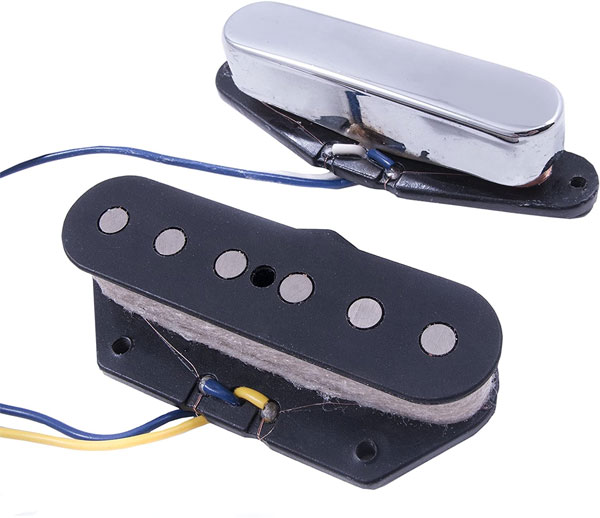
| Estimated Price | $80 |
| Type | Single Coil |
| Position | Bridge & Neck |
My Review: The Deluxe Drive Telecaster pickups ramp up the classic twang, with specific specifications and components used to highlight the best aspects of the instrument. No matter where you find yourself on the fretboard, you can enjoy a warm, immersive tone with clear and rich harmonics.
Using polysol-coated magnet wire, Fender has managed to create the ideal balance between dynamic control and sonic energy. Flush-mount polepieces ensure that you get an even response from every string so that your dynamics remain consistent.
When playing chords, the Deluxe Drive pickups allow you to control the grittiness of the Telecaster. This is also due to the choice of magnets. Alnico III’s keep the tone focused, and respond to the velocity of your playing impressively.
A chrome neck pickup cover slots onto any Telecaster model without detracting attention from the undeniable beauty of the guitar. You also get a vinyl-coated output wire, a plastic bobbin, and of course all of the installation hardware you need to hook up the pickups.
Who is this best suited for: If you like to crank up the gain on your amplifier, these Deluxe Drive pickups provide the perfect bridge between the amp and your Telecaster. The overworld design makes them ideal for producing the classic Tele snap that has graced so many great records over the years.
Bottom Line: High-output single-coil pickups like the Deluxe Drive set are sometimes plagued with noise issues, but due to Fender’s extensive experience producing guitar electronics, they have found a way to increase the drive without increasing the hum.
11. Seymour Duncan Little 1959

| Estimated Price | $90 |
| Type | Humbucker |
| Position | Bridge |
My Review: The Little ’59 pickup provides a well-balanced tone. This Telecaster-exclusive device is a full-sized P.A.F pickup for installation in the bridge position. Tonally, it produces a slightly scooped midrange with a full-bodied humbucker resonance.
Using a ceramic bar magnet, the pickup is ideal for everything from country to straight-up rock n’ roll. It is compatible with all varieties of Telecaster neck pickups, enhancing the tone of the instrument and honing in on its sweetest frequencies.
Like all Seymour Duncan pickups, the Little ’59 Tele was hand made in Santa Barbara, California. It comes equipped with a 4-conductor lead wire which allows you to utilize split and parallel wiring options depending on your preferences.
Who is this best suited for: If you’re looking for the classic Telecaster tone that is heard throughout the history of country music, you’ll be impressed with the Little ’59 bridge pickup. It’s a great choice for guitarists who are happy with their neck pickup but require a bridge pickup to add a little more character to their output.
Bottom Line: Built to the impeccably high standard that Seymour Duncan pickups are renowned for, the Little ’59 Tele edition is a wonderful bridge pickup. Rather than transforming the natural tone of the Telecaster, it highlights the best aspects, scooping the midrange slightly and providing a well balanced tone in the process.
12. Fender Custom Shop Texas Special

| Estimated Price | $190 |
| Type | Single Coil |
| Position | Bridge & Neck |
My Review: Fender’s line of Custom Shop pickups features some of their finest offerings. Designed to combine smooth harmonics with the warm Texas tone, these Telecaster pickups feature several interesting components and design techniques.
Both pickups are overwound and constructed with Alnico V magnets. The magnet wire is coated in enamel. This combination results in more warmth across the frequency range of the Telecaster. For clean tones or gritty break ups, the Custom Shop Texas Special pickups perform brilliantly.
In the bridge pickup, Fender has used height staggered magnets and a copper plated steel bottom plate. These work together to increase the output and presence of the Telecaster, especially in the mid-range frequencies.
Also, it’s worth mentioning that the neck pickup has a nickel/silver cover which improves the clear and warm tone. The wiring scheme is very easy to understand, and installing these pickups on your Tele is a simple and quick process.
Who is this best suited for: Rather than being suited to a specific style of guitar playing, the Custom Shop Texas Special pickups facilitate rock, blues, country, and even metal. The way that the bridge and neck pickups interact with one another provides ultimate freedom over the dynamics and tone of your Telecaster.
Bottom Line: Designed to produce blistering hot tones, with a notable presence in the midrange, these Fender-designed Tele pickups are a force to be reckoned with. They’re easy to install and add the perfect amount of heat to your guitar’s output.
13. Fender Pure Vintage Reissue
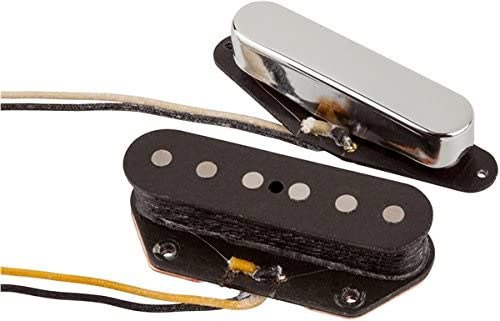
| Estimated Price | $110 |
| Type | Single Coil |
| Position | Bridge & Neck |
My Review: Alnico V magnets are the perfect choice for creating the classic vintage Telecaster tone that guitarists worldwide hold in such high regard. Fender has tapped into the methods used to create the early Tele pickups when designing the Pure Vintage Reissue pickups.
A tin-plated copper base plate offers enhanced resonance and clarity. The mid-range has been scooped slightly, a technique used to draw attention to the tight low-end frequencies and allow the highs to sing with ultimate freedom.
One thing that is for certain, is that Fender doesn’t shy away from trying new methods to get the very best tones out of their pickups. This is apparent when analyzing the Pure Vintage Reissue pickups.
With period-correct cloth output wire and a fiber bobbin, these pickups produce a warm, inviting tone across the frequency range of the guitar. Then there are the flush-mount pole pieces which ensure even string response and dynamic consistency.
Who is this best suited for: Guitarists who want to take their Telecaster back in time to the original sound will love the vintage tone of these Reissue pickups. They provide you with additional warmth and a stronger want that was present on the early models back in the 1950s.
Bottom Line: Fender’s Pure Vintage Reissue Telecaster pickups have Alnico V magnets installed within them, which leads to a more focused and dynamically expressive output. The staggered bridge pickup polepieces ensure balance on every string, and enamel-coated magnet wire adds a vintage touch.
14. EMG T-System

| Estimated Price | $190 |
| Type | Single Coil |
| Position | Bridge & Neck |
My Review: The EMG T-System is specifically designed to slot onto your Telecaster and extract every ounce of energy from the guitar’s natural tone. Completely solderless, this pickup system is incredibly easy to install. It includes a prewired control plate, a stereo output jack, an output cable, and all of the required springs and mounting screws.
The tone produced by the EMG T-System pickups has plenty of substance to the mid-range. They don’t completely overhaul the natural tone of the Telecaster, but rather highlight its best qualities. A well-rounded set, the T-system pickups are equipped with Alnico V magnets which add to the definition and clarity.
For single-coil pickups, the T-System is impressively quiet. You don’t get the usual hum that comes with high-output pickups, but this is not at the expense of the tonal character. The treble frequencies have plenty of definition and you can switch between the bridge and neck positions for sonic variation.
Another quality of the EMG T-System is its sleek, distinguished design. With a metallic plate and two matte-black pickups, the system slots onto your Telecaster without drawing too much attention. They fit with all color schemes of the Telecaster thanks to the understated aesthetics.
Who is this best suited for: The EMG T-System is a well-rounded set of pickups. In terms of tone, I’d recommend it to Telecaster players who want to simply amplify the natural resonance of the guitar, without adding too much coloration. These pickups are incredibly easy to install, so you don’t need to be an expert to hook them up to your Tele.
Bottom Line: Included with the EMG T-System are all of the required components for easily replacing the existing pickups on your Telecaster. The solderless design makes them incredibly easy to set up, you also get a control plate with volume and tone pots pre-installed. These pickups are of great value and produce a classic Tele tone.
15. Fender Vintage Noiseless
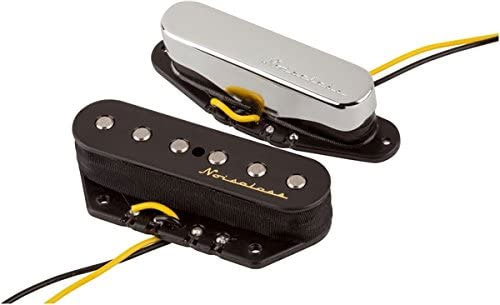
| Estimated Price | $160 |
| Type | Humbuckers |
| Position | Bridge & Neck |
My Review: Many pickups claim to be “noiseless”, and you’re right to be skeptical when you hear that description. However, Fender isn’t the type of manufacturer to make false claims. Their Vintage Noiseless Tele pickups deliver noise-free performance without compromising on tone or power.
The magnet wire inside the pickups is largely responsible for the tone of these brilliant humbuckers. It’s coated in enamel and gives the pickups a vintage sound that is typically associated with the Tele. The choice of magnets also contributes to the authenticity of the pickup’s tone.
Rather than opting for the more popular choice of Alnico V magnets, Fender chose to go with Alnico 2’s. This results in an output that is warmer than usual, with a gentle attack and a subdued midrange. Due to the lack of aggression in the mids, the treble and bass frequencies become more prominent.
Fender has also used a vinyl-covered output wire and a plastic bobbin. This further reinforces the smooth tone of the pickups and ensures that have adequate durability. Included with the Vintage Noiseless pickups are all of the necessary installation hardware, screws, and electronic components.
Who is this best suited for: Some guitarists don’t mind the noise issues that commonly come with single-coil pickups. However, there are certain styles of playing that required noiseless performance. If you fall into this category, the Vintage Noiseless Tele pickups will make a great addition to your guitar.
Bottom Line: Using Alnico 2 magnets and enamel-coated magnet wire, these Fender Noiseless pickups can deliver a warm, immersive tone that is rooted in vintage eras. The pickups are designed specifically to minimize the unwanted hum that comes with single coils, and they deliver a crisp tone that is versatile and pristine.
Choosing the Right Telecaster Pickups
There are many components that combine to influence the tone and sound of an electric guitar. Indeed, the choice of strings, the amplifier, and the effects pedal all play a deciding role. Perhaps the most influential mechanism, however, is the pickups that are installed on the instrument.
Telecasters are exceptionally versatile electric guitars. Over their long history, they have been used for various genres, styles, and tones. The term “Telecaster twang” was coined to describe the iconic lead guitar sound that the Fender classic became famous for.
Fender has installed many of their original pickups on the various Telecaster models throughout the decades. Some pickups were designed for creating specific tones, while others are seen as being multi-dimensional. Choosing the best-suited Telecaster pickups for your needs requires some background knowledge on the way that these devices shape the tone and performance of the guitar.
The Original Telecaster Tone
Leo Fender was known to be very fond of western swing and country music, therefore the early Telecaster models were designed with a vision to produce the tones associated with these styles. Country music in the 1950s was rife with large archtops and pedal steel guitars.
With this in mind, it makes sense that the first Telecaster models used a bridge pickup that resembled a pedal-steel guitar, combined with the dark, warm tone of the early single-coil neck pickup. Fender’s early wiring scheme highlighted this contrast.
One notable milestone in the construction of the Telecaster was Fender’s decision to use two very different pickups installed on the instrument. At the time, it was much more common to find the same pickups installed in the bridge and neck positions on the vast majority of classic electric guitars.
This unique pickup design played a large role in shaping the original Telecaster sound, but over the years, Fender began to experiment even more with pickup combinations. This would lead to the Tele becoming a multi-faceted instrument that slowly moved away from its country and western swing heritage.
The Telecaster “twang” has become a thing of legends since the first models were introduced. The list of iconic guitarists who choose the Telecaster as their weapon of choice is quite remarkable. It includes names like Keith Richards, Jeff Buckley, Muddy Waters, Jimmy Page, and George Harrison.
A large contributing factor in the prolonged success of the Telecaster is its versatility. Although originally it was preferred by country and blues guitarists, it has become a popular choice for surf rock, classic rock, indie rock, and even heavier styles like metal.
Fender produces many different versions of the Telecaster. Their American range is the top-tier offering, while their Mexican and Squire ranges are more affordable, but still wonderful instruments nonetheless.
A Brief History of Telecaster Pickups
The lineage of Telecaster pickups is rich with innovative devices. Fender’s ability to evolve throughout the years is one of the qualities which has allowed them to maintain their position at the forefront of guitar and pickup manufacturing.
Out of all of Fender’s beloved guitars, perhaps the Telecaster has been used with the vastest selection of pickups. This is why the Tele is used across multiple genres, and why its loyal fanbase continues to experiment with different pickup styles to this day.
The earliest bridge pickups used on the Telecaster were adapted from a pickup that Fender designed and was already using on lap steel guitars. These pickups were readily available for a long time but recently have become more of a rarity due to their historic significance.
The lap steel bridge pickups are rated between 5.8K and 8K, depending on the magnet wire they were paired with. This lower DC rating produces a treble-rich, harmonically abundant tone, and instantly transforms the Tele into a vintage-sounding instrument.
Installing these early bridge pickups was no easy feat. It required the rectangular bases to be trimmed down in order to fit onto the guitar, and a sturdy baseplate was installed to secure the pickup. These baseplates were commonly made from steel plated copper or zinc and worked in conjunction with the alnico III slug magnets which were relatively weak compared to the magnets used today.
Interestingly, the metal baseplates had a significant impact on the tone of the Telecaster. This is due to the electrodynamic effect that the different metal materials had on the Alnico III. For example, using copper or brass baseplates produces a thicker tone with increased output. Swapping the baseplate material is a quick and effective way to alter the tone.
Single Coil vs. Humbucker
One of the beautiful things about the Telecaster is that it is equally suited to be paired with single-coil and humbucker pickups. Before you decide on which pickup to install on your Tele, it’s imperative that you understand the basic differences between the two most popular pickup types.
Single coil pickups have been around for considerably longer than humbuckers. In fact, humbuckers were created to alleviate some of the issues caused by early single-coil pickups. Let’s take a look at the key differences.
A single-coil pickup, as the name suggests, consists of a single coil of wire. This wire is wrapped around six magnetic poles. One of the standout qualities of single-coil pickups is that they are great at generating voltage from the vibration of a Telecaster’s string.
However, single-coils do have their drawbacks. For starters, much like an antenna, they are liable to pick up unwanted sounds, and this causes them to hum pretty often. In terms of tone, they sound bright and clean and are popular amongst guitarists who play a lot of lead parts and solos.
Humbucker pickups were designed to combat the noise issues related to single-coils. They do this by literally “bucking the hum”. With two coils rather than one which is linked in series, out of phase. This design causes the coils to cancel each other out, eliminating any noise issues and raising the voltage level from the string vibrations.
The result is a quieter pickup with a larger overall output. Humbuckers also have a significant impact on the tone of a Telecaster, producing a fatter sound that is warmer than that of their single-coil counterparts.
It’s important to understand that both single-coil and humbucker pickups can be used for any style of guitar playing. Telecaster players aren’t limited to one choice and can use a specific type of pickup to enhance specific tone-related aspects of the guitar.
Pickup producers, like Fender, EMG, and Seymour Duncan all offer a range of single-coil and humbucker pickups that are compatible with the Telecaster. If you’re looking for a thicker, low-noise option, I’d recommend opting for a humbucking pickup. If you need more power in the treble-end and would like a clearer tone, single-coils are probably the best choice for your Tele.
Pickup Positions
Telecasters use pickups in two positions: the bridge and the neck. Most models also feature a three or five-way pickup selector, which allows you to toggle between the bridge, middle, and neck pickup positions.
Due to the position of the pickups, they both cause notable changes to the overall tone of the Telecaster. The bridge pickup highlights the signal from the string vibration closer to the bridge, which results in a punchier, tighter tone.
Bridge pickups are commonly used for heavy, distorted riffs because of their improved definition and the prominence of the high-end frequencies. Selecting the bridge pickups is a great way to ensure that the Telecaster cuts through the mix.
At the neck of the Telecaster, the string tension is not as strong. This means that the string vibrates with great amplitude, and the tone that the neck pickup produces is, therefore, thicker, more mellow, and less bright than the bridge pickup.
Selecting the neck pickup of the Tele is great for intricate styles of playing. Fingerpicking guitarists tend to favor the neck pickup, due to the less sharp sound it produces. It’s also great for jangly chord sequences that need to sound warm and immersive.
The best way to learn about the different tones produced by the neck and bridge pickups is to physically experiment with them. It’s likely that you’ll find that using different pickup positions for certain parts will be beneficial, rather than sticking to one position. Telecasters are highly versatile instruments, and they can be used to produce a vast array of tones. This is largely down to the variation in the pickup positions.
Pickup Magnet Types
On your search for the best Telecaster pickups, you’ve probably noticed that many of the options use different magnet types. The magnet is hugely impactful on the performance of the pickup, whether it’s a single-coil or humbucker device.
The most common type of pickup magnet is Alnicos. These are composed of iron, nickel, cobalt, and copper. There are different variations of Alnico magnets that are designed to produce varying tones.
If you’re unfamiliar with the way that different magnets impact the tone of the pickups, it can be a little overwhelming trying to choose the right one for your desired tone. Thankfully, there are clear differences that I’ll explain below.
Alnico II
Commonly found in original PAF humbucking pickups, Alnico II magnets have a moderate coil wind. When combined with “hotter” coils, they are a great choice for heavier styles of playing on your Telecaster, like metal or hard-rock.
The overall tone of Alnico II magnets is quite soft, with good clarity and sweet harmonics. The treble frequencies are nicely rounded-off, but this changes when the magnet is paired with a hotter coil wind, which results in a more energetic tone and improved note separation when playing chords on your Telecaster.
Alnico V
For extracting conventional rock tones from a Telecaster, the Alnico V is the most reliable choice. They produce a hot, edgy tone that has more attitude than Alnico II or III magnets. For chord playing, Alnico V magnets produce thick clusters of notes that are ideal for playing chunky riffs. Their midrange is slightly warmer than other magnets which also makes them exceptional for lead guitar tones. Alnico V magnets are highly suitable for the bridge pickup of a Fender Tele.
Alnico VIII
Although they’re nowhere near as common as the two previously mentioned magnets, Alnico VIII is employed by Telecaster players who want to deviate from the stereotypical tones associated with the instrument. They provide a good blend of precision and grit and are great at extracting every ounce of “chunk” from the Telecaster’s fretboard.
Alnico III
I mentioned Alnic III magnets in an earlier section, describing how these devices were installed on many of the early Fender Telecasters. They’re less commonly used these days, but they do provide an effective portal into the world of vintage Tele tones. Alnico III magnets are made without cobalt, which results in a lower magnetic pull.
The sound produced by Alnico III magnets is consistent, with a well-rounded tonality and a certain softness. They’re best suited to the bridge pickups because they allow the strings to ring out more cleanly. A popular choice for Telecaster players is to install Alnico II magnets in the bridge pickups, and Alnico III magnets in the neck. This combination offers a smooth Tele tone.
Ceramic
Ceramic magnets are great for creating a modern tone, but they are less commonly used with Telecasters than Alnico magnets. Still, you can use them to produce a tighter low end, with a higher output than their Alnico equivalents. They’re a popular choice for metal guitarists, thanks to the additional aggression and attitude they produce.
Pole Pieces
Another integral component in Telecaster pickups is the pole pieces. They are responsible for balancing the volume of each individual string. They are screw-like mechanisms that run through the coil of the Telecaster’s pickup, serving as a magnetic conductor for the strings.
It’s common to find one pole piece per string, but in humbucking pickups, there are two per string. There are several designs that are used depending on the guitar type, for example, the Fender Stratocaster is likely to feature staggered pole pieces, but these aren’t common in Telecasters.
In some cases, the Telecaster pickup’s magnets can double up as the pole pieces. If this is the case, the magnet is mounted within the middle section of the coil. In other cases, the pole pieces are made from steel rods or bolts that can be adjusted. They run through the coil of the pickup and make contact with the magnet, which is mounted underneath.
Telecaster pickups with adjustable poles can be raised or lowered. This is useful because it provides a reliable, method for balancing the loudness of each string. Fixed poles, on the other hand, are installed at specific heights to rebalance the string volumes.
Coils & Windings
Another contributing factor to the overall tone of Telecaster pickups is the interaction between the magnet and the coil, which involves the process of winding. Pickups start with a magnet, which creates a magnetic field of varying strength.
Then, a wire coil which is made from insulated, thin wire, creates an electromagnetic coil. This device becomes magnetically charged when it is exposed to electricity. In some cases, when the coil passes through the magnetic field, the electricity is generated through inductance.
The wire coil is placed inside the field of the magnet. However, if the coil remained stationary, electricity will not be generated. Therefore, to create electricity, the wire coil or the magnetic field must be moving. This is achieved by putting the Telecaster strings into the magnetic field alongside the coil.
When the strings are strummed or plucked, the vibrations disturb the magnetic field. This creates what is known as a sympathetic electrical voltage within the coil. The voltage is subsequently transmitted to the guitar amp, and the Telecaster’s amplified sound is created.
The coil and windings are generally more predictable than magnets. Made from a thin copper wire, the coil is wound around a bobbin. There are several metals that could be used for this process, but copper is the most common due to its affordability and availability.
Coil windings are significant when it comes to determining the sound of the Telecaster pickup. The tighter the coil winds around the bobbin, the more output voltage is produced by the pickup, and as a result the more resistance the coil possesses.
Fender Tele Pickups
Fender started making pickups as early as the 1940s, and they continue to be one of the leading innovative forces in this field today. It makes sense that the original manufacturer of the Telecaster would know exactly how the pickups should be designed in order to get the best out of the instrument.
All of Fender’s popular guitars, like the Telecaster, Stratocaster, Jazzmaster, and their bass guitars like the Precision bass and Jazz bass have specifically designed pickups. Fender designs these pickups to work perfectly with the specs of the instrument, and therefore they are one of the most reliable choices for Telecaster pickups.
Seymour Duncan Tele Pickups
Another leading provider of Telecaster pickups is Seymour Duncan. Formed in 1976, the company has gone on to become arguably the most prolific pickup manufacturer in the world. Their collection covers all electric guitar types, in addition to acoustic and bass pickups.
Seymour Duncan’s quarter pound Telecaster pickups are perhaps their standout offering for the revered Fender guitar. Many guitarists choose to swap out the stock pickups on their Tele and opt for a Seymour Duncan set, due to the distinctive tone that produces.
Summary
Choosing the right pickups ensures that you get the premium tone and sound out of this wonderful guitar. It ultimately comes down to personal preference and the predominant style of your playing.
After reading this comprehensive guide, hopefully, you’ve identified the perfect pickups to install on your Telecaster. Whichever pickups you choose from this list, I’m sure you’ll enjoy the sound they create when paired with your guitar!

My name is Chris and I’ve had a passion for music and guitars for as long as I can remember. I started this website with some of my friends who are musicians, music teachers, gear heads, and music enthusiasts so we could provide high-quality guitar and music-related content.
I’ve been playing guitar since I was 13 years old and am an avid collector. Amps, pedals, guitars, bass, drums, microphones, studio, and recording gear, I love it all.
I was born and raised in Western Pennsylvania. My background is in Electrical Engineering, earning a Bachelor’s degree from Youngstown State University. With my engineering experience, I’ve developed as a designer of guitar amplifiers and effects. A true passion of mine, I’ve designed, built, and repaired a wide range of guitar amps and electronics. Here at the Guitar Lobby, our aim is to share our passion for Music and gear with the rest of the music community.

well done !